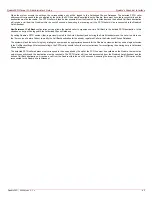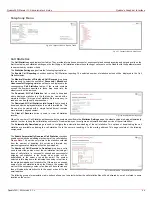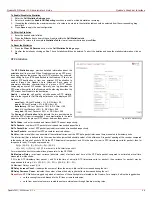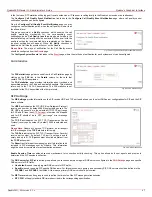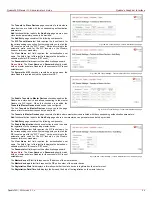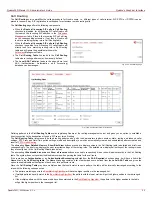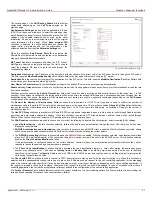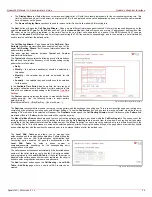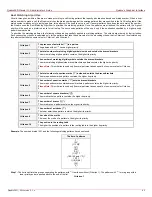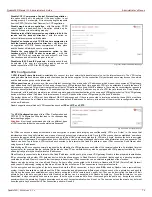
QuadroFXO Manual II: Administrator's Guide
Quadro's Graphical Interface
QuadroFXO; SW Version 5.1.x
57
The second page of the Call Routing Wizard offers different
components depending on the Call Type selected on the
previous page.
Use Extension Settings drop down list is applicable to SIP and
IP-PSTN call types and allows you to select the extension (also
Auto Attendant) on behalf of the call that will be placed. The SIP
settings of the selected extension will be used as the caller
information. If an entry is not selected from this list, the original
caller information will be kept. When Keep original DID
checkbox is selected, the called destination will receive the
original caller’s information and not the information of the
extension selected from the Use Extension Settings list.
When the checkbox Add Remote Party ID is selected, the
Remote-Party-ID parameter is being delivered to the destination
side upon call establishment procedure.
SIP Tunnel drop-down list appears only when the “SIP_Tunnel”
Call Type is selected on the previous page. The list is used to
select the particular SIP tunnel to route the calls through the
corresponding Quadro.
Fig. II-106: Call Routing Wizard - page 2
Destination Host requires the IP address or the host name of the destination (for a direct call) or the SIP server (for calls through the SIP server).
This field is named Modified Destination Host if the Pattern field on the first page of this wizard contains “@” symbol.
Destination Port requires the port number of the destination or of the SIP server. This field is named Modified Destination Port if the Pattern field
on the first page of this wizard contains “@” symbol.
User Name and Password require the identification settings for the public SIP server or servers requiring authentication.
Enable Activity Timeout checkbox is used to limit time-to-live period of routing pattern (makes sense if accept or failure feedback arrives too late
from the destination).
Checkbox selection enables the Activity Timeout text field which is used to insert a routing pattern activity timeout (in the range from 1 to 180
seconds). When timeout is configured, the routing pattern will be active within the defined time frame and if no response has been received from the
destination during that period, the pattern will be stopped and next routing rule might be optionally considered (depending on the Fail Reason
configuration on the corresponding pattern).
The Restrict the Number of Simultaneous Calls checkbox is only available for IP-PSTN call type and is used to restrict the number of
simultaneous calls to the public SIP server with the same username at the same time. This checkbox enables Allowed Call Count text field which
requires the number of simultaneous calls allowed in a range from 1 to 64. If you leave this field empty, no limitation will apply to the number of
simultaneous logons.
The Use RTP Proxy checkbox is available for SIP and IP-PSTN call types and is applicable when a route is used for calls through Quadro between
peers that are both located outside the Quadro. When this checkbox is selected, RTP streams between external users will be routed through
Quadro. When the checkbox is not selected, RTP packets will move directly between peers.
The AAA Required checkboxes are used to choose one or more of the following Authentication, Authorization, and Accounting (AAA) settings:
•
Local Authentication – with this checkbox selected, callers will need to pass authentication through the Local AAA table (see below) when
dialing the current pattern.
•
RADIUS Authentication and Authorization – this checkbox is present when a RADIUS client is enabled. With this checkbox selected, callers
will need to pass the authentication through RADIUS server (see above) when dialing the current pattern.
•
The RADIUS Accounting checkbox is accessible when the
is enabled. With this checkbox selected, no authentication will take
place, but CDRs (call detail reports) of the calls made through this routing record will be sent to the RADIUS server. This checkbox selection
enables the Client Code Identification checkbox.
If the authentication is configured based on the caller’s address, callers will pass the authentication automatically; otherwise they will be
required to identify themselves by a username and a password.
•
The Client Code Identification checkbox selection activates the code identification feature: a caller, after dialing the destination phone
number, may optionally enter “*” and then an Identity Code. An Identity Code is an arbitrary digit string entered by the user to identify a
specific call or call group. The Identity Code is sent with CDR to the RADIUS server and might be used by a billing program for grouping the
calls having the same Identity Code.
The Check with 3PCC checkbox is used to request a 3PCC approval before placing a call with the specific routing rule. When this checkbox is
selected and the corresponding routing rule is used to place a call, Quadro sends a request to the call controlling application for the managing
person to accept or reject the specific call (it can be a popup window or any other type of dialog box, depending on the call controlling application). If
the request is accepted, the call will be placed. Otherwise, if the request is rejected, the call will be skipped. In case of no feedback from the call
controlling application, the call will be accepted after a timeout defined in the configuration of the call controlling application.
The Failover Reason(s) radio buttons indicate whether the system should use the next matching pattern if call setup with the current routing rule
fails and allows choosing the reasons to be considered as a failover.

